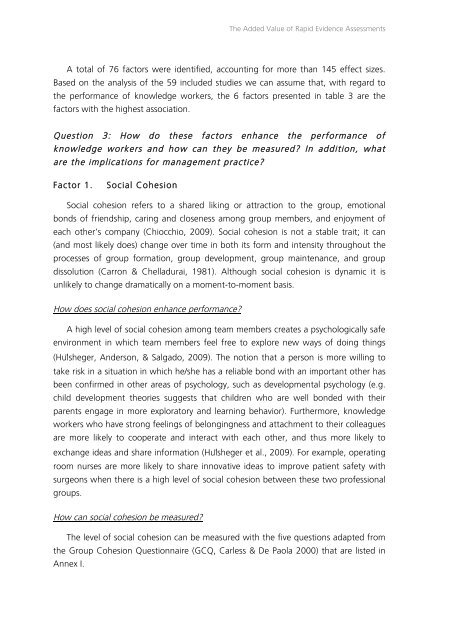In Search of Evidence
jqluvth
jqluvth
You also want an ePaper? Increase the reach of your titles
YUMPU automatically turns print PDFs into web optimized ePapers that Google loves.
The Added Value <strong>of</strong> Rapid <strong>Evidence</strong> Assessments<br />
A total <strong>of</strong> 76 factors were identified, accounting for more than 145 effect sizes.<br />
Based on the analysis <strong>of</strong> the 59 included studies we can assume that, with regard to<br />
the performance <strong>of</strong> knowledge workers, the 6 factors presented in table 3 are the<br />
factors with the highest association.<br />
Question 3: How do these factors enhance the performance <strong>of</strong><br />
knowledge workers and how can they be measured? <strong>In</strong> addition, what<br />
are the implications for management practice?<br />
Factor 1.<br />
Social Cohesion<br />
Social cohesion refers to a shared liking or attraction to the group, emotional<br />
bonds <strong>of</strong> friendship, caring and closeness among group members, and enjoyment <strong>of</strong><br />
each other’s company (Chiocchio, 2009). Social cohesion is not a stable trait; it can<br />
(and most likely does) change over time in both its form and intensity throughout the<br />
processes <strong>of</strong> group formation, group development, group maintenance, and group<br />
dissolution (Carron & Chelladurai, 1981). Although social cohesion is dynamic it is<br />
unlikely to change dramatically on a moment-to-moment basis.<br />
How does social cohesion enhance performance?<br />
A high level <strong>of</strong> social cohesion among team members creates a psychologically safe<br />
environment in which team members feel free to explore new ways <strong>of</strong> doing things<br />
(Hülsheger, Anderson, & Salgado, 2009). The notion that a person is more willing to<br />
take risk in a situation in which he/she has a reliable bond with an important other has<br />
been confirmed in other areas <strong>of</strong> psychology, such as developmental psychology (e.g.<br />
child development theories suggests that children who are well bonded with their<br />
parents engage in more exploratory and learning behavior). Furthermore, knowledge<br />
workers who have strong feelings <strong>of</strong> belongingness and attachment to their colleagues<br />
are more likely to cooperate and interact with each other, and thus more likely to<br />
exchange ideas and share information (Hülsheger et al., 2009). For example, operating<br />
room nurses are more likely to share innovative ideas to improve patient safety with<br />
surgeons when there is a high level <strong>of</strong> social cohesion between these two pr<strong>of</strong>essional<br />
groups.<br />
How can social cohesion be measured?<br />
The level <strong>of</strong> social cohesion can be measured with the five questions adapted from<br />
the Group Cohesion Questionnaire (GCQ, Carless & De Paola 2000) that are listed in<br />
Annex I.


